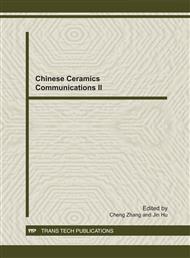[1]
J.L. Blackburn, D.C. Selmarten, R.J. Ellingson, M. Jones, O. Micic and A.J. Nozik: J. Phys. Chem. B Vol. 109 (2005), p.2625.
Google Scholar
[2]
H.Y. Li, O. Wunnicke, M.T. Borgström, W.G. Immink, M.H. van Weert, M.A. Verheijen and E.P. Bakkers: Nano. Lett Vol. 7 (2007), p.1144.
DOI: 10.1021/nl0627487
Google Scholar
[3]
N.S. Norberg, G.L. Parks, G.M. Salley and D.R. Gamelin: J. Am. Chem. Soc Vol. 128 (2006), p.13195.
Google Scholar
[4]
V. Biju, Y. Makita, T. Nagase, Y. Yamaoka, H. Yokoyama, Y. Baba and M. Ishikawa: J. Phys. Chem. B Vol. 109 (2005), p.14350.
DOI: 10.1021/jp0526187
Google Scholar
[5]
F.L. Xue, J.Y. Chen, J. Guo, C.C. Wang, W.L. Yang, P.N. Wang and D.R. Lu: J. Fluoresc Vol. 17 (2007), p.149.
Google Scholar
[6]
D.R. Larson, W.R. Zipfel, R.M. Williams, S.W. Clark, M.P. Bruchez, F.W. Wise and W.W. Webb: Science Vol. 300 (2003), p.1434.
Google Scholar
[7]
B. Ballou, B.C. Lagerholm, L.A. Ernst, M.P. Bruchez and A.S. Waggoner: Bioconjug. Chem Vol. 15 (2004), p.79.
Google Scholar
[8]
R. Yang, W. Ji, Y. Yan, Q. Fei , Y. Mu and Q. Jin: Journal of Jilin University (science edition) Vol. 43 (2005), p.863.
Google Scholar
[9]
R. Hardman: Environ. Health. Perspect Vol. 114 (2006), p.165.
Google Scholar
[10]
K.T. Yong, I. Roy, H. Ding, E.J. Bergey, P.N. Prasad: Small. Vol. 5-17 (2009), p. (1997).
Google Scholar
[11]
Z. Chen, H. Chen, H. Meng, G. Xing, X. Gao, B. Sun, X. Shi, H. Yuan, C. Zhang, R. Liu, F. Zhao, Y. Zhao and X. Fang: Toxicology and Applied Pharmacology. Vol. 230-3 (2008), p.364.
DOI: 10.1016/j.taap.2008.03.022
Google Scholar
[12]
A.W. al-Shawi and R. Dahl: J Chromatogr. A Vol. 850 (1999), p.137.
Google Scholar
[13]
C. Scriver, M. Kan, S. Willie, C. Soo and H. Birnboim: Anal. Bioanal. Chem Vol. 381 (2005), p.1460.
DOI: 10.1007/s00216-005-3125-4
Google Scholar
[14]
P. Liang, L. Yang, B. Hu and Z. Jiang: Anal. Sci Vol. 19 (2003), p.1167.
Google Scholar
[15]
Z. Fan, B. Hu, Z. Jiang and S. Li: Anal. Bioanal. Chem Vol. 378 (2004), p.456.
Google Scholar
[16]
M. Zougagh, P.C. Rudner, A.G. de Torres and J.M. Cano Pavón: Anal. Bioanal. Chem Vol. 378 (2004), p.423.
Google Scholar
[17]
M. Chu, X. Shen and G. Liu: Nanotechnology Vol. 17 (2006), p.444.
Google Scholar
[18]
X. Gao, Y. Cui, R.M. Levenson, L.W. Chung and S. Nie: Nat. Biotechnol Vol. 22 (2004), p.969.
Google Scholar
[19]
A. Hoshino, K. Hanaki, K. Suzuki and K. Yamamoto: Biochem. Biophys. Res. Commun Vol. 314 (2004), p.46.
Google Scholar


